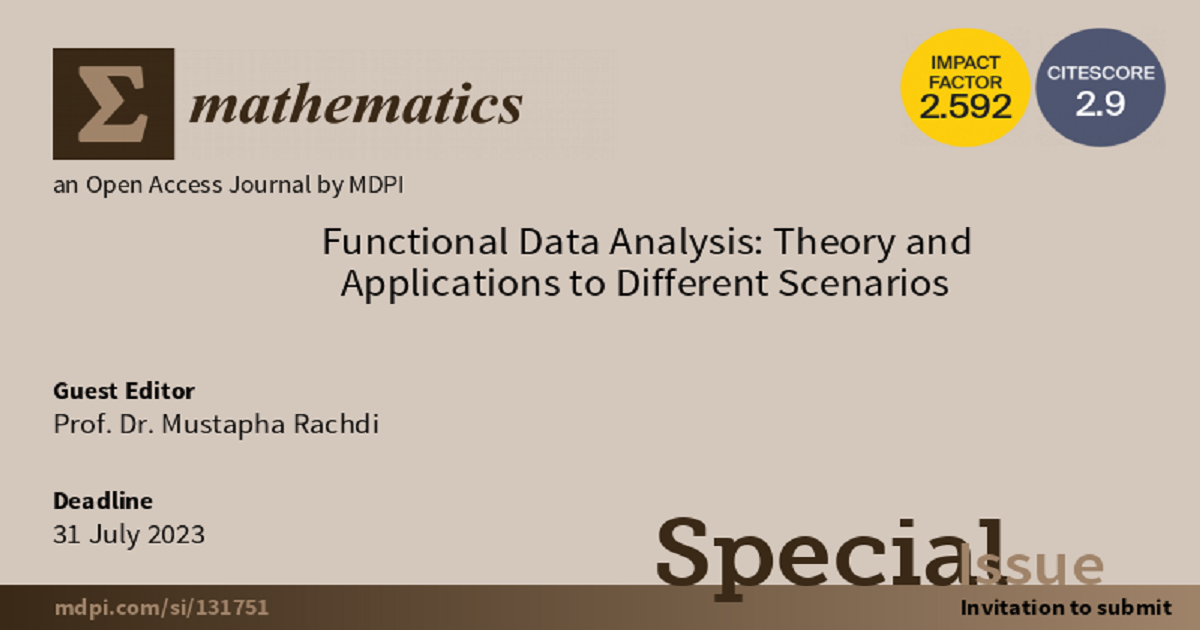Functional Data Analysis: Theory and Applications to Different Scenarios
A special issue of Mathematics (ISSN 2227-7390). This special issue belongs to the section "Probability and Statistics".
Deadline for manuscript submissions: closed (31 July 2023) | Viewed by 24172

Special Issue Editor
Special Issue Information
Dear Colleagues,
The digital revolution is responsible for improving machine learning and functional data analysis (FDA). In a rapidly changing global economy, businesses must take advantage of all the analytical tools available to stay competitive. Organizations that invest in FDA and other techniques can learn from their mistakes, optimize problem solving, correct inefficiencies, and increase bottom line results.
FDA is an important technique used by many modern businesses in the digital age. FDA identifies patterns in data that might not be discernible, allowing business owners to make decisions based on statistics rather than guesswork.
In this Special Issue of the prestigious journal Mathematics, we will highlight notable advances in functional data processing techniques. In fact, we treat the field in a different way, considering case studies to illustrate how FDA ideas work in practice across a wide range of fields. These include criminology, epidemiology, economics, archaeology, rheumatology, psychology, neurophysiology, meteorology, biomechanics and education, as well as simulated data.
The main objective of this Special Issue is to bring together original research in statistical machine learning and data mining from academia, industry and government in a relaxed and stimulating atmosphere to focus on the development of theory, methods and applications of statistical learning.
Topics include, but are not limited to, big data analysis, classification, computational biology, covariance estimation, graphical models, high-dimensional data, learning theory, model selection, network analysis, precision medicine, and signal and image processing.
Prof. Dr. Mustapha Rachdi
Guest Editor
Manuscript Submission Information
Manuscripts should be submitted online at www.mdpi.com by registering and logging in to this website. Once you are registered, click here to go to the submission form. Manuscripts can be submitted until the deadline. All submissions that pass pre-check are peer-reviewed. Accepted papers will be published continuously in the journal (as soon as accepted) and will be listed together on the special issue website. Research articles, review articles as well as short communications are invited. For planned papers, a title and short abstract (about 100 words) can be sent to the Editorial Office for announcement on this website.
Submitted manuscripts should not have been published previously, nor be under consideration for publication elsewhere (except conference proceedings papers). All manuscripts are thoroughly refereed through a single-blind peer-review process. A guide for authors and other relevant information for submission of manuscripts is available on the Instructions for Authors page. Mathematics is an international peer-reviewed open access semimonthly journal published by MDPI.
Please visit the Instructions for Authors page before submitting a manuscript. The Article Processing Charge (APC) for publication in this open access journal is 2600 CHF (Swiss Francs). Submitted papers should be well formatted and use good English. Authors may use MDPI's English editing service prior to publication or during author revisions.
Keywords
- functional data analysis
- high-dimensional statistics
- complex data processing
- non-parametric statistics
- multivariate statistics
- epidemiology
Benefits of Publishing in a Special Issue
- Ease of navigation: Grouping papers by topic helps scholars navigate broad scope journals more efficiently.
- Greater discoverability: Special Issues support the reach and impact of scientific research. Articles in Special Issues are more discoverable and cited more frequently.
- Expansion of research network: Special Issues facilitate connections among authors, fostering scientific collaborations.
- External promotion: Articles in Special Issues are often promoted through the journal's social media, increasing their visibility.
- e-Book format: Special Issues with more than 10 articles can be published as dedicated e-books, ensuring wide and rapid dissemination.
Further information on MDPI's Special Issue polices can be found here.





